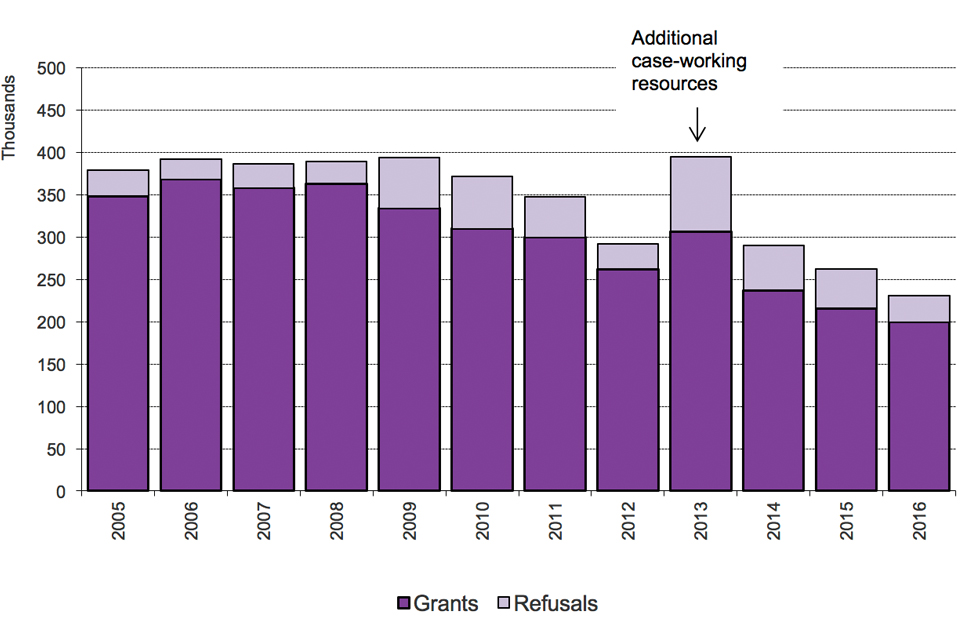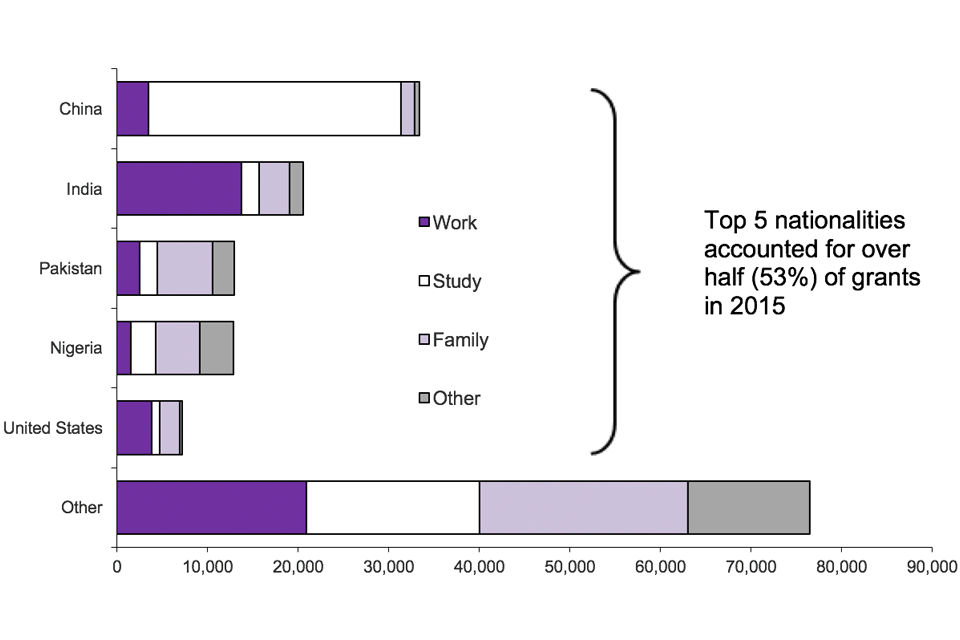Extensions of stay
Published 23 February 2017
Valid: 23 February 2017 to 24 May 2017
Data relate to the calendar year 2016 and all comparisons are with the calendar year 2015, unless indicated otherwise.
Back to Immigration statistics October to December 2016 content page.
This is not the latest release. View latest release.
1. Key facts
There were 32,214 or 12% fewer decisions on extensions in 2016. Of the 230,256 decisions, 87% were grants (199,624) and 13% (30,632) were refusals.
There was a 7% increase for the largest category of work-related grants, Tier 2 Skilled work (to 63,578), corresponding to a 7% increase in Tier 2 sponsored applications (main applicants). However, rule changes led to falls in other routes. The Tier 1 General category fell 72% to 1,449, reflecting its previous closure to new entrants; and overseas domestic workers fell 36% to 2,346, likely reflecting past changes so that new entrants to this category cannot obtain extensions. For further details see the Work topic.
Study-related grants of extensions fell by over a third (34%) to 42,032 in 2016, corresponding with a 33% fall in Tier 4 sponsored applications (main applicants). This is likely reflecting previous falls in the numbers granted visas, together with tightening of the rules, such as the new use of the ‘genuineness’ test. For further details see the Study topic.
Family-related grants of extensions increased by 16,735 to 61,258 (38%) in 2016. This rise is accounted for by increases of 11,672 to 37,034 in grants to partners and by 5,027 to 24,129 in the Family life (10-year) category. These increases likely reflected previous changes, that is a longer residence eligibility period before it was possible to apply to stay in the UK permanently (settlement), and a requirement to obtain an extension after 2.5 years, both implemented under new family Immigration Rules from 9 July 2012. For further details see the Family topic.
Grants of extensions in other categories fell by 9,870 to 17,640 (36%) in 2016 corresponding with a 33% fall in decisions of such cases. Further analysis suggests that a significant part of the decrease was accounted for by fewer grants of discretionary leave outside of the rules on compassionate grounds, which fell from 8,265 to 1,598 (main applicants only).
There were 30,632 refusals of an extension in 2016. Of these, 5,800 related to work, 2,257 to study, 10,750 to family and 11,825 to other categories. Correspondingly, the refusal rates for work, study, family and other categories were 7%, 5%, 15% and 40% respectively.
2. Grants of extensions by reason, and refusals
| Year | Total decisions | Total grants | Work | Study | Family (1) | Other (1) | Refusals |
|---|---|---|---|---|---|---|---|
| 2012 | 291,827 | 261,810 | 140,947 | 87,073 | 16,627 | 17,163 | 30,017 |
| 2013 | 394,592 | 306,598 | 122,463 | 117,810 | 40,434 | 25,891 | 87,994 |
| 2014 | 290,377 | 236,740 | 88,404 | 79,778 | 36,634 | 31,924 | 53,637 |
| 2015 | 262,470 | 215,799 | 80,005 | 63,761 | 44,523 | 27,510 | 46,671 |
| 2016 | 230,256 | 199,624 | 78,694 | 42,032 | 61,258 | 17,640 | 30,632 |
| Change: latest year | -32,214 | -16,175 | -1,311 | -21,729 | +16,735 | -9,870 | -16,039 |
| Percentage change | -12% | -7% | -2% | -34% | +38% | -36% | -34% |
2.1 Table notes
Source: Home Office, Immigration Statistics October to December 2016, Extensions table ex 01 q.
(1) The introduction of the new Family life (10-year) route in July 2012 ‘Statement of intent: Family Migration’ means that the total number of family and other category grants are not fully comparable over time.
3. Long-term trends in grants and refusals of extensions of stay
The chart below illustrates longer-term trends in grants and refusals to extend stay by calendar year back to 2005.

3.1 Chart notes
Source: Home Office, Immigration Statistics October to December 2016, Extensions table ex 01.
4. Nationalities granted an extension
(Excludes dependants)
Data for grants by nationality in 2016 are planned to be published in ‘Immigration Statistics January to March 2017’, due to be released on 25 May 2017.
4.1 Top 5 nationalities granted an extension to stay, 2015
(Total number of grants 163,676, excludes dependants)

Chart notes
Source: Home Office, Immigration Statistics October to December 2016, Extensions table ex 02.
5. Data tables
Further data on extensions are available in Extensions tables ex 01 to expc 01 o.
More detailed analysis on family extensions and additional tables for years ending June were included in the Immigration Statistics April to June 2015 release Family topic to assist users in understanding the trends before and after the changes to the Family Immigration Rules in July 2012.
A short statistical article on ‘Extensions of stay by previous category’ was published alongside the Immigration Statistics April to June 2013 release to provide further detailed information. Updates of the more detailed tables provided in the article are included in the Immigration Statistics April to June 2013 Extensions tables and were summarised in the Immigration Statistics January to March 2016 release Extensions topic.
Data for grants by previous category in 2016 are planned to be published in ‘Immigration Statistics January to March 2017’, due to be released on 25 May 2017.
6. Background information
The figures in this section relate to individuals inside the UK extending or changing the status of their stay in the UK. Data include dependants unless stated otherwise.
The numbers reflect past changes in the levels of those entering the UK in different categories, policy and legislative changes, for example closure of categories or changes to the length of visas granted to people entering the UK, or to the rules on whether individuals can switch categories. The figures may also reflect the level of case-working resources available.
6.1 Migration transparency data webpage
A range of key input and impact indicators are currently published by the Home Office on the Migration transparency data webpage.
6.2 Staying in the UK
In February 2017, the Home Office published its ‘Statistics on changes in migrants’ visa and leave status: 2015’ formerly known as the ‘Migrant journey’ which shows how migrants subject to immigration control change their immigration status or achieve settle
